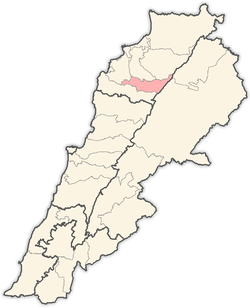Hasroun
| Hasroun www.hasroun.co حصرون | |
|---|---|
| City | |
 Hasroun www.hasroun.co Location within Lebanon | |
| Coordinates: 34°14′31″N 35°58′46″E / 34.24194°N 35.97944°ECoordinates: 34°14′31″N 35°58′46″E / 34.24194°N 35.97944°E | |
| Country |
|
| Governorate | North Governorate |
| District | Bsharri District |
| Elevation | 1,600 m (5,200 ft) |
| Highest elevation | 1,600 m (5,200 ft) |
| Lowest elevation | 1,450 m (4,760 ft) |
| Population | |
| • Total | 12,000 |
| Time zone | EET (UTC+2) |
| • Summer (DST) | EEST (UTC+3) |
| Dialing code | +961 |
Hasroun (also Hasrun or Hasroon, Arabic: حصرون ) is a village located in the Bsharri District in the North Governorate of Lebanon. It is situated in the Valley of Qadisha, overlooking the southern branch of this valley, the Qannoubine Valley.

View of Hasroun
It owes its nickname of the Rose of Mount Lebanon to its predominantly red-tiled roof houses. The population is Maronite Catholic.
Hasroun gave the Maronite Church two Patriarchs, Patriarch Jacob Awad (1705-1733) and Patriarch Simon Awad (1743-1756). From Hasroun came also the noted family of orientalists, the Assemani, among them the famous Giuseppe Simone Assemani, author of Bibliotheca Orientalis and Ephraemi Syri opera omnia quae extant.
Twin Towns
External links
| |||||||||||||||||||||
